Italy 2022

The Sunday Paper #431
October 16, 2022
Happy Sunday!
I’ve returned from my working vacation in Italy and France, where I spent two weeks teaching at ICA Arts in Monte Castello di Vibio, followed by a week long vacation in the Loire Valley with my hubby, son, and a couple I met when I was an exchange student in Germany in 1986. It was an incredible experience. Here’s a brief recap (with special thanks to Ron Shaull, Lore Spivey and Beth Stockdell for sharing some of their lovely photos):
My son and I flew to Rome on Saturday, 9/18 and stayed overnight in a hotel near the airport. The next morning, he headed off for a week of exploring Florence and Milan, and then he met up with my husband in Rome, who flew in a week later. They spent a week exploring Rome; the Herculaneum and Mt. Vesuvius, outside of Naples; and the island of Capri. I met up with them after teaching (more on that at the end of this post).
Meanwhile, I returned to the Rome airport the next morning to meet up with seven of the ten students who were enrolled in The Art of Papercraft, and we were escorted by Victoria – our ICA Arts liaison – to a chartered bus that took us to Monte Castello di Vibio. The school is in a walled Italian hill town that was built in the 14th century, located right in the center of Italy, in Umbria.
 |
 |
The rest of our group was there waiting for us – another three participants and the other three instructors (Carol Barton, Denise Carbone, and Amanda Degener). Five participants are members of my Paper Year program and three are members of Ali Manning’s Handmade Book Club, and a couple are members of both groups!

There’s a book about the charming town of Monte Castello di Vibio called Three Bells of Civilization: Life in an Italian Hill Town. It is known for having the smallest Italian theater in the world, which (unfortunately) was under construction.

This illustration from the book shows the layout of the town – it is tiny with about 200 inhabitants within the walls, 5-10 businesses, a bell tower, a school, two churches, a park, and many homes. There is a defunct hotel which was just purchased and is being renovated. Coincidentally, I met the hotel’s American owner who had dinner with us at the school one night, and he’s read Dard Hunter’s book, Papermaking – how crazy is that?? I had to ask him why he’d read the book, because he wasn’t an artist and didn’t have a connection to paper. It turns out that he read it in high school, when he broke both legs and was bedridden for many weeks, and his mother kept him supplied with books from the library.
It is easy to get lost in the maze of small streets, but you eventually end up at a landmark. A walk around the perimeter of the town takes less than 10 minutes. Most participants stayed in the main building, which included dormitory-style rooms, a library, a kitchen and dining hall. A few stayed off campus, and we four instructors stayed in a four-bedroom home with a shared bath and kitchen.
We started classes the next day (Monday) and divided into two groups of five students. Each group attended a morning and an afternoon class on Mondays and Wednesdays with two instructors, and a morning and afternoon class with the other two instructors on Tuesdays and Thursdays. Here you see the three main rooms we utilized: one for me; Carol and Denise shared a space (alternating morning and afternoon classes); and Amanda had indoor and outdoor papermaking spaces.
 |
 |
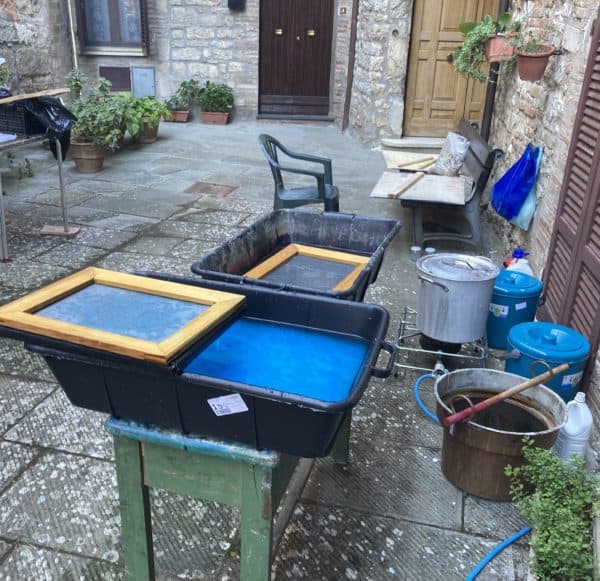 |
Amanda taught papermaking (kudos to her for creating a functioning papermaking facility out of nothing – which began with getting water from the second floor down to the first floor). She also showed participants how to dye papers featuring many of the techniques utilized by Cave Paper, the company she founded and sold a couple of years ago. Each participant went home with an incredible sample book that showed off a variety of papers.
 |
 |
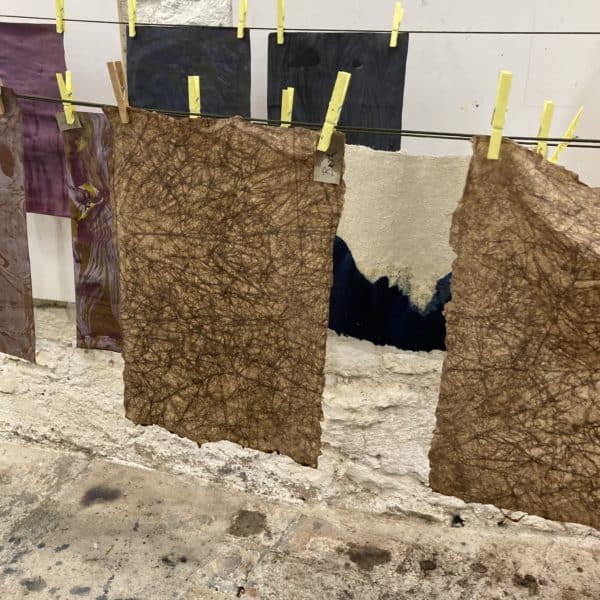 |
In my class, we focused on one technique each day. I met with each group four times, and I showed them how to work with paper in four ways: we created a couple of woven paper structures, a shadow lantern, bendable paper, and inflatable forms.
 |
 |
 |
 |
Denise taught two traditional sewn bookbindings. She did an amazing job of working with what she had on hand since the facility had never been used for paper or book making. She had sewing frames constructed in Italy (her own sewing frame hung from the rung of a chair stacked on top of a table) and she resurrected a really old guillotine.
 |
 |
Carol’s class focused on designing pop-ups. Her course was based on the mechanics that are featured in her fabulous Pocket Paper Engineer series of books. And it is thanks to Carol that I got to go to Italy in the first place. She was the one who made contact with the school and invited the rest of us to teach with her.
 |
 |
 |
I began each day at a tai chi class taught by Amanda in the town park. It was chilly at 7am, but the walk to the park often yielded an incredible vista of fog filling the valley below. The photo shows the view across the valley to Todi, another hill town – sometimes the tower was the only thing sticking out of the clouds.
 |
 |
I taught my class each morning, from 9am – 1pm, Monday through Thursday. Lunch was from 1-2pm, and I had the rest of the afternoon off. The students had their afternoon classes from 3-7pm, and we gathered for dinner at 8pm. I spent my afternoons going for walks, doing yoga, and thinking about future art projects. I didn’t find the time conducive to making my own work, as I’d hoped. Carol, in contrast, created a lovely collection of watercolors during her free afternoons.
 |
 |
The food was amazing! Talented chefs Katia and Federico treated us to a breakfast buffet, three course lunches and four course dinners, featuring traditional Umbrian cuisine and local table wines. I’m glad the food was served to us as shown (i.e. portioned, vs all-you-can-eat).
 |
 |
 |
 |
 |
 |
 |
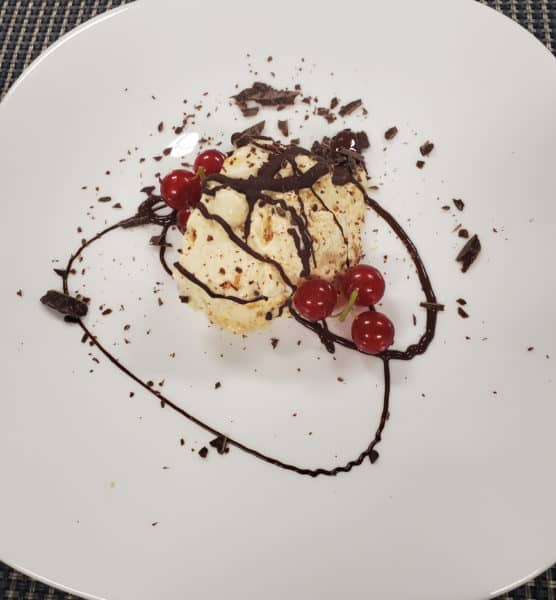 |
We took several fun field trips to surrounding areas. David Voros, the director of ICA Arts, put together a wonderful array of places for us to see on Fridays, Saturdays and Sundays.
Our first trip started with a visit to La Madonna del Bagno, a small church with a tree behind the altar that is said to have performed miracles. People who came here to pray for their friends and family commissioned tiles to give thanks to the Virgin Mary for her various interventions. Over the centuries, these tiles began to cover the walls and corridors of the sanctuary.
Afterwards, we stopped for pastries and coffee and then visited the infamous pottery town of Deruta, specifically the pottery studio of the Nulli family. We got to see pottery throwing and painting demonstrations, and I was fascinated by the stenciling process the painter used. She had a stencil made from tracing paper with tiny holes pricked along the design. She placed the stencil on top of a plate and pounced over it with a bag filled with charcoal, which transferred the design to the plate. This gave her the outline she needed for painting intricate patterns.
 |
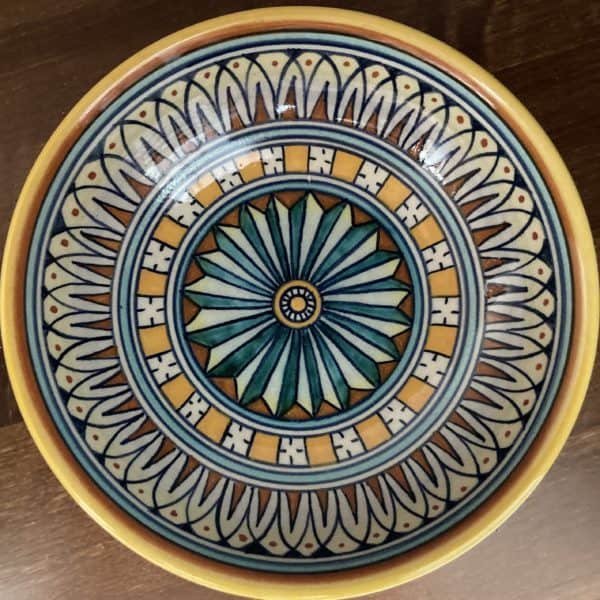 |
The most relevant trip took place next – to the Fabriano Paper and Watermark Museum. We had an official tour (first row below) followed by time to view several rooms filled with watermarked papers and moulds (second row).
Roberto Mannino, an Italian paper artist from Rome, took Amanda and me to visit a local papermaker, Luigi, who fabricates products that are sold in Fabriano boutiques around Italy. Pictured in the third row are his huge Hollander beater (he has a pump attached to move the pulp into the next room, where he makes paper); a small scale papermaking machine; and an assortment of papers.
The rest of the group toured Assisi, and we all met back in Monte Castello di Vibio for dinner and a presentation by Roberto, whom I also had a chance to interview for my podcast, Paper Talk (coming soon).
 |
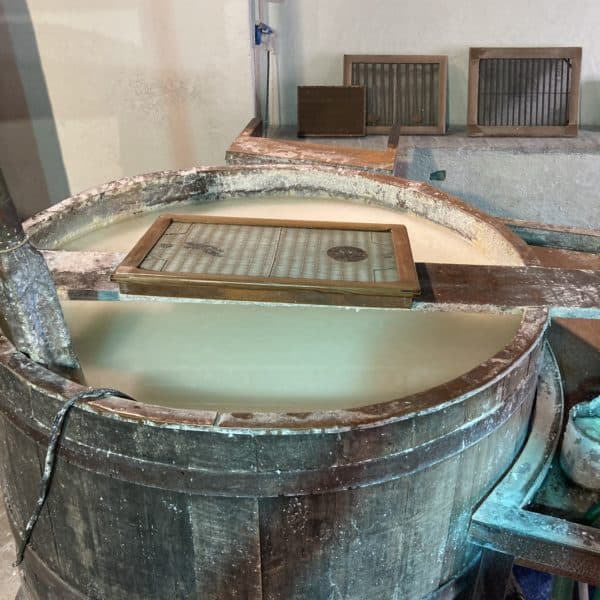 |
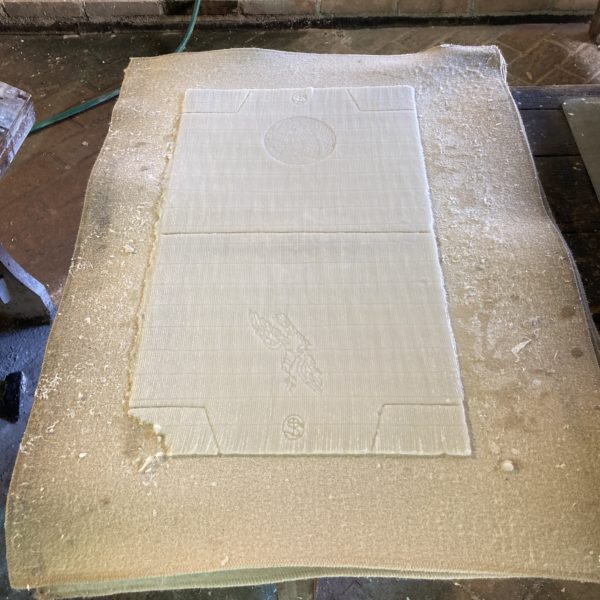 |
 |
 |
 |
 |
 |
 |
We spent a few hours in Perugia that weekend, which had an amazing underground built by the Etruscans, Baci chocolates and some really interesting manhole covers.
 |
 |
Our second week of classes ended on Thursday, September 29th. That evening, we had a mini exhibition in the dining hall, which many townspeople, including the mayor, attended. It was a lovely celebration of two productive weeks of working with paper, and each participant had a table to display their work on.
 |
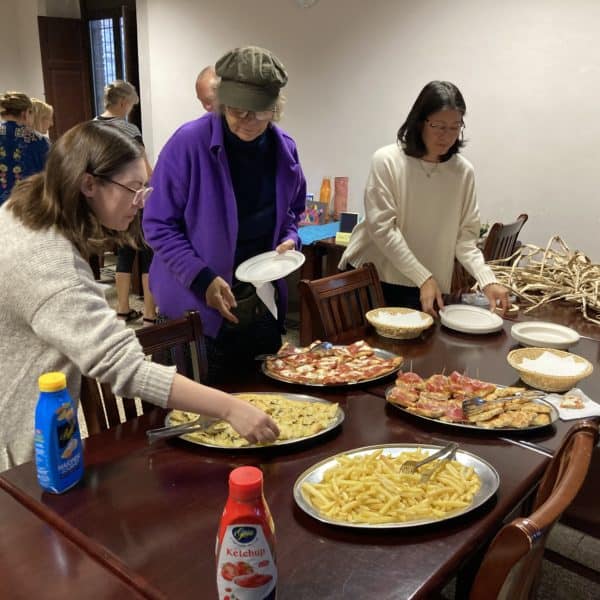 |
 |
That second weekend, we visited Florence, where Carol and Denise and a few of us met up with a former student of theirs. Patricia took us to the central market for lunch and some fun shops, including the Fabriano Boutique, where I saw some of Luigi’s products. It was pouring rain that day, so I didn’t take many photos (the bad weather gave us the opportunity to have coffee and gelato). We walked by several famous buildings (like the duomo) and got to a couple of tourist attractions, including San Marco, which had a room filled with manuscripts. My favorite discovery there was a couple of vitrines filled with the tools and materials used to make the manuscripts.
 |
 |
Saturday, our last day, included a visit to Orvieto, a charming tourist town filled with shopping streets. The cathedral there was built in striped gray and white stone, and the “stained glass” windows were created from thin stone rather than glass. I only know this because Amanda was with me and mentioned she’s seen windows like this at the Beinecke Library at Yale.
After Orvieto, we visited Marmore Falls, a man-made waterfall created by the ancient Romans. The waterfall is turned on and off and is only running at full steam for an hour each day. We were there during that hour, and we stayed to see it slow to a trickle.
 |
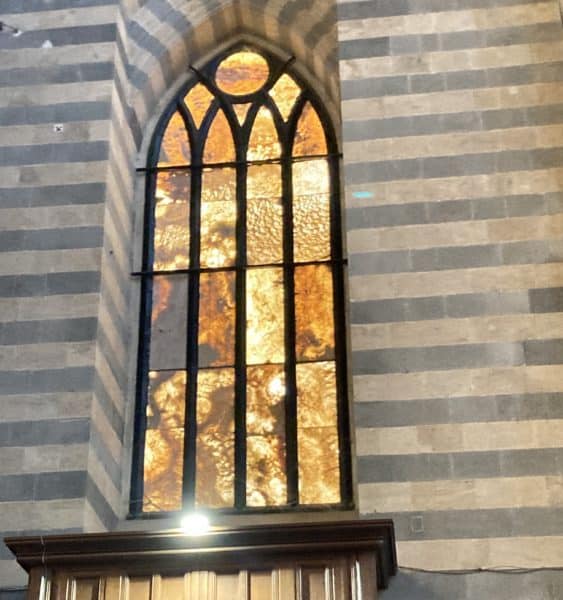 |
 |
 |
After a final celebratory dinner that night, we took the bus to the Rome airport bright and early the next morning, where I met up with Ted and Will. We flew to Nantes, France to meet up with our German friends who had arrived the day before. We had a lovely time together in the Loire Valley near Saumur (although Heinz tested positive for Covid the day we flew in, so he isolated in a separate detached building. As of this post, so far so good in terms of anyone else contracting Covid).
We spent the week touring castles and caves, cooking together, sleeping in (something I never do), playing cards and enjoying each other’s company. This is my favorite photo from the week: the three of us in front of the castle at Saumur.

Here are a few more photos, highlighting that week:
- Heinz, Barbara and their pups at our rented house that is built into the rock in Fontevraud, France
- Ted and Will at the stables of the Cadre Noir in Saumur, France
- Barbara and Ted on the roof of Château de Montsoreau, with the Loire River in the background
- Château de Chinon
- A baguette machine, LOL. We had a boulangerie with fresh baguettes in our neighborhood, so we didn’t try it.
- Tapa (bark cloth) mounted onto a folding screen at the Fontevraud Modern Art Museum (a fun paper discovery)
- The tombs of Eleanor de Aquitaine, Henry II and Richard the Lionheart
- Barbara and I took a bicycle tour through an underground winery and did a tasting
- A book of paper cubes that I found in the Château de Montsoreau gift shop
 |
 |
 |
 |
 |
 |
 |
 |
 |
Putting this post together took awhile, but YOU are so worth it! Thanks for reading, and I’ll be back with a more normal Sunday Paper next week.
And if you’d like more insight into the Italy portion of the trip, you might be interested in these supplementary items:
- Participant Lore Spivey created a wonderful photo diary about the entire two weeks at ICA Arts.
- Participant Beth Stockdell wrote a fun travel log documenting her trip, complete with photos and videos.
- I created a five-minute video about the workshop at ICA Arts, featuring the maze-like paths through the village.



11 Comments
Helen, thank yo use much for sharing your experience…….the perfect accompaniment to a very cool, autumn morning (and coffee).
Makes me want to hop on a plane! Italy is indeed beautiful every way you turn!
Thanks so much,
Ruth
Hi Ruth, I’m enjoying the image of you reading about my trip over coffee on a cool autumn morning :). Thanks for reading.
I just shared your link here with my Mum so now you have two people drooling!
To heck with rocks and scissors….I’ll just take paper thank you very much! And paper in Italy….what’s not to love!
Have a good weekend, thanks again,
Ruth
Hi, Helen!
Many thanks for taking the time to share your experiences with us. For those of us who weren’t able to join you, your illustrated account was indeed “the next best thing to being there”!
Again, my thanks–
Chuck
Thanks, Chuck! In some ways, maybe the ‘next best thing’ is even better :). I glossed over a few things, like jet lag, not the best bed top sleep on, etc. As they say, “there’s no place like home”.
WOW and amazing and wonderful journey in a fabulous country and into the world of paper.
Thanks, Janet!
Fabulous story of your expedition! Thanks for sharing.
You’re welcome!
Helen, how wonderful! Thanks for sharing, all of it sounds so amazing!
Moe Snyder
Thanks for reading, Moe!